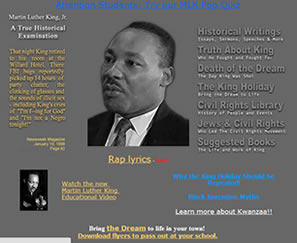With professional journalism imploding and an exploding infosphere online, on cable, and on air that’s bursting with questionable news and information, how can a consumer or citizen become informed without being misled?

This new information landscape is as vast as the Sahara, but full of mirages. You can look up almost anything on the Internet. But most of what’s offered is really trying to sell a product, service, or point of view. Take, for instance, a website aimed at students, www.martinlutherking.org, that looks at first like a tribute to the slain civil rights leader but is actually a character assassination produced by white supremacists.
Explosion of Information
Comparing the infosphere of the late 20th century to that of the early 21st, resembles holding a child’s balloon up to the Goodyear blimp. In just two decades the Internet has become an indispensable information utility. For those who know how to search and filter it, the explosion of widely available information is exciting and empowering. There’s a silver lining in the digital cloud.
For those who can’t distinguish fact from clever fiction, however, it can be bewildering and misleading, a fun-house mirror of the world. In a society where the well-informed have no more say in the voting booth than the un- and misinformed, news and information literacy has become a necessary skill for citizens.
So here’s a tool for vetting news and information in the digital age. The “SMELL” test won’t make you foolproof, but it can help you become a savvy information detective. Apply it to any content purporting to be factual from any source — face-to-face, to Facebook, to Fox, the New York Times, and online “to infinity and beyond.” On some major issues, fact-checking websites will sniff out bias for you, e.g., Factcheck, Politifact, and Snopes. But most of the time, you’re on your own.
Introducing the SMELL test
S stands for Source. Who is providing the information?
M is for Motivation. Why are they telling me this?
E represents Evidence. What evidence is provided for generalizations?
L is for Logic. Do the facts logically compel the conclusions?
L is for Left out. What’s missing that might change our interpretation of the information?
Source
It’s essential to know who is providing the information you want to check for reliability. That’s because humans are incapable of objectivity. Even journalists suffer from biases — conscious and unconscious — arising from their gender, generation, geography, race and class. As Nelson Mandela has observed, “where you stand depends on where you sit.”
Bias begins with self-interest. We may think of ourselves as honest as a nun in a confessional booth. But we are all self-interested information providers. For instance, when a cop asks how fast you were going, do you fess up — or provide a discounted estimate?
Quality news organizations can mute, but not moot, a reporter’s biases with a diverse staff. But media often impose their own self-interested bias, a commercial bias. Such a slant may take the form of sensation displacing substance, pandering to audience prejudices, avoiding content embarrassing to major sponsors, or shaping news to attract those demographics that advertisers covet — upscale 18- to 54-year-olds — and shunning stories about younger, older and poorer members of the community. Or it could be “churnalism,” cheaply assembled content suggested — and often supplied — by PR agents, but disguised as news.
It’s useful to vet sources — both of information and those quoted within content — by placing them on a mental PIE chart. The P stands for Proximity — is the information first-hand or hearsay? The I is for Independence. Is the source free from conflicts of interest? And the E represents Expertise, either from long experience or specialized study.

What if you can’t identify an information source? Or it has a vague name wrapped in stars and stripes, like “Citizens for American Progress?” Legitimate information sources will always disclose who they are. On the web, they will have an “about us” link to help you assess their independence and expertise.
If the producer of the content isn’t identified, believe nothing from it. Within articles, be skeptical of anonymous sources. Their lack of accountability encourages unreliability.
Motivation
The source’s motivation matters because if the purpose is persuading rather than informing, we should raise our skepticism shields. Those hoping to sell us on a viewpoint, a product, or a candidate are likely to cherry-pick only those facts that support their purpose. Unethical persuaders spread half-truths and sometimes outright lies.
How do you distinguish between persuaders and informers? Informers attribute every assertion of fact that’s not based on common knowledge or the author’s direct observation to a source identified fully enough for the audience to apply the PIE test. Informers practice fairness — dispassionately presenting all relevant sides to an issue in a context that aids audience understanding. Except possibly for empathy, the presentation is unemotional (anger, fear, titillation). No judgment of right or wrong is proffered. No action is called for.
Informers are faithful to evidence rather than ideology. They avoid sweeping generalizations. They practice transparency (explaining how they know what they claim to know and warning about what they don’t). They call attention to their errors.
Evidence
Whenever we hear a new assertion about what’s real or true, we should ask: How do you know that?
Trustworthy information providers should attempt to confirm or verify at least the most consequential or controversial claims of their sources. That requires finding at least one other source, independent of the first and with an acceptable PIE score, who provides a similar description of an event.
If the evidence supplied falls short or appears suspect, you can use the web to check fact-claims yourself. Just enter the claim in a search engine. Or use Facebook to ask for help from friends with greater expertise.
Logic
The fundamental question here is, does this make sense: externally — in light of everything else I know, and internally — is the evidence provided within the report adequate to support the conclusions reached?
Obviously, the more you know, the better your answer to the first question will be. That’s why it’s important to keep up with news from reliable sources. Information that jars you, or that’s “too good to be true,” should arouse suspicion.
Failures of internal logic common to news reports include: anecdotes presented as proof of trends; innuendo — suggesting conclusions that stretch beyond the evidence presented; and flawed comparisons, e.g., likening Saddam Hussein to Adolph Hitler.
Left out
Omission and marginalization are among the most powerful and subtle means of introducing bias because we tend to notice only what’s emphasized.
It’s helpful to look online for reports from alternative sources — especially those that differ by gender, generation, geography, race or class — that might present a different take on the same story. Often missing facts are linked to missing stakeholders. The least powerful are most likely to be overlooked.
A former journalist, professor, and now an author, John McManus founded a consumer report for San Francisco Bay Area journalism, GradeTheNews.org, at Stanford. His most recent book is “Don’t Be Fooled: A Citizen’s Guide to News and Information in the Digital Age.” His books have twice won the annual research award of the Society of Professional Journalists.

